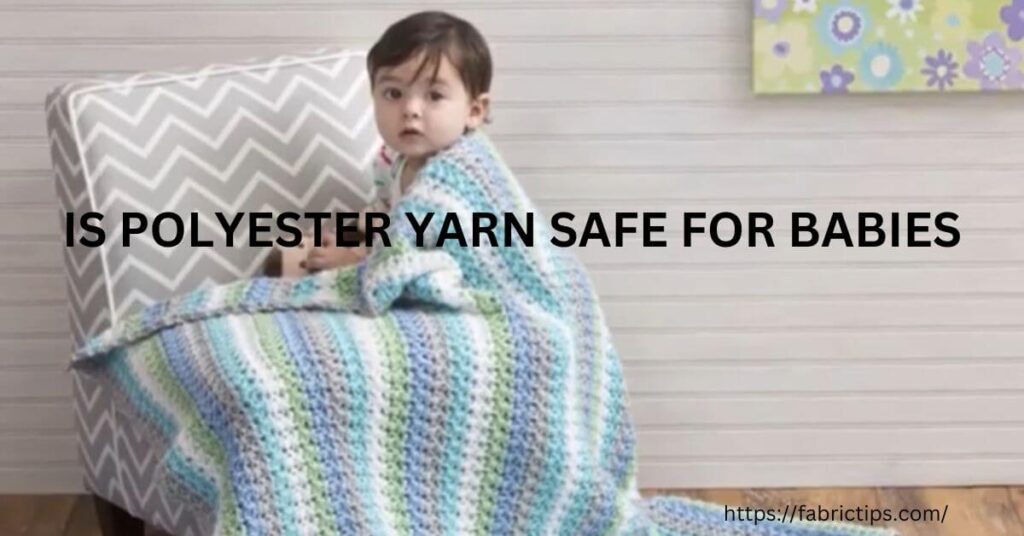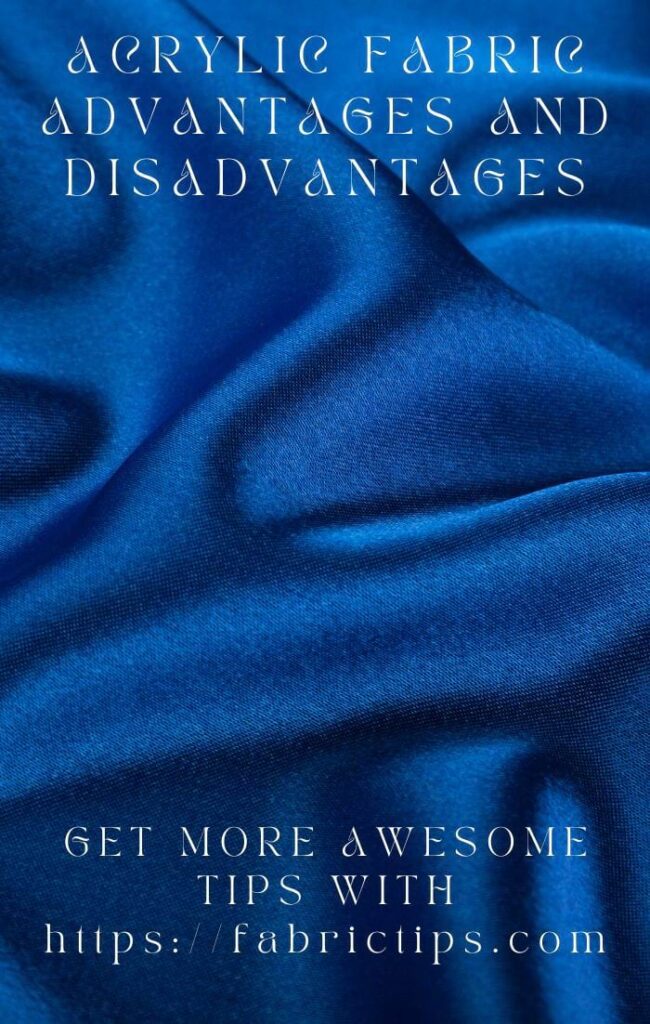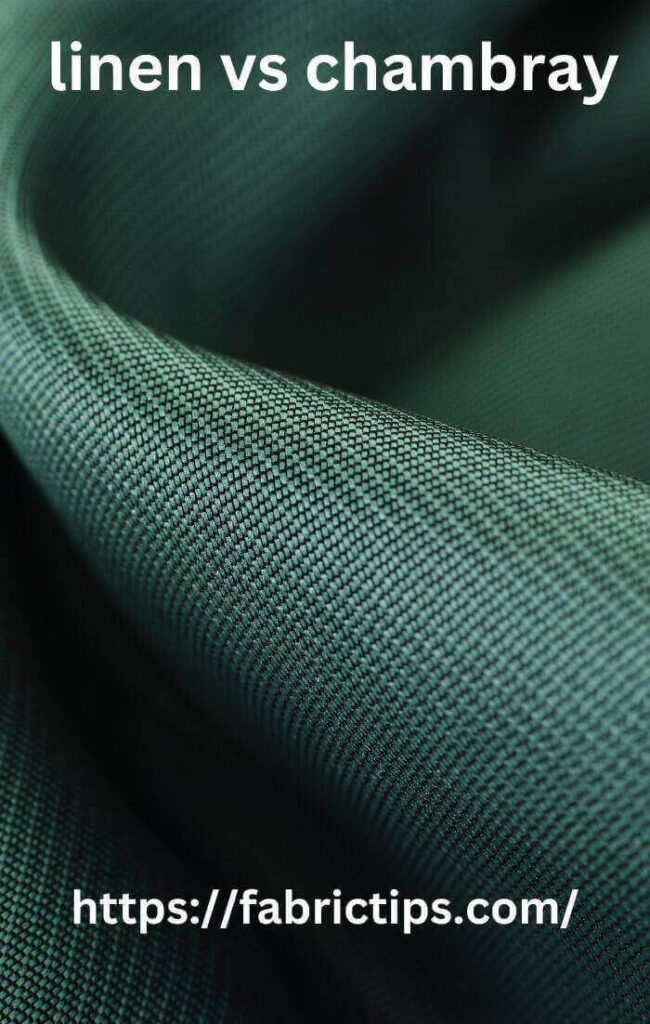Last Updated on December 13, 2025 by Wahid
Imagine snuggling your precious newborn in a brand-new blanket. It should be soft, cuddly, and feel like a warm embrace, right? But when it comes to choosing the yarn, the options can be overwhelming.
Polyester yarn is a popular choice for its softness and durability. But is polyester yarn safe for babies delicate skin, especially during sleep? Let’s untangle the threads and discover the best yarn for a cozy and healthy start for your little one.
Is Polyester Fabric Safe for Babies: In-Depth Analysis

Polyester yarn often takes center stage due to its affordability, wide range of colors, and undeniable softness. However, for parents prioritizing comfort and safety for their little one’s delicate skin, a question arises: Is polyester yarn the safest option for babies? The answer, like most things in parenting, isn’t a simple yes or no. Let’s delve deeper into the world of polyester yarn, exploring its pros and cons to determine if it’s the perfect lullaby for your baby’s needs.
Unveiling the Two Sides of Polyester Yarn for Babies
Pros:
- Durability Champions: Polyester yarn is a champion of resilience. It can withstand countless washes and playful tugs, making it ideal for the inevitable spills and messes that come with little ones. This translates to long-lasting blankets, drool-proof bibs, and clothes that can handle a playground adventure.
- Softness Symphony: Let’s face it, softness is a top priority for a baby’s comfort. Certain types of polyester yarn, particularly minky fabrics, can achieve a remarkably soft and cuddly feel. Imagine a blanket that feels like a gentle cloud against your baby’s delicate skin.
- Easy-Care Convenience: Parents appreciate anything that simplifies their lives. Polyester yarn is a low-maintenance material. It often resists wrinkles and dries quickly, making laundry day a breeze. No more worrying about delicate hand-washing or special drying cycles.
Cons:
- Breathability Blues: Unfortunately, polyester yarn falls short when it comes to breathability. Unlike natural fibers, it doesn’t allow for easy airflow. This can trap heat and moisture close to your baby’s skin, potentially leading to overheating and discomfort, especially during sleep.
- Sensitivity Symphony (Not the Good Kind): Some babies, especially those with sensitive skin, might experience irritation from polyester yarn. The synthetic fibers can cause itchiness, redness, or even eczema flare-ups.
- Chemical Concerns: A lingering concern for some parents is the potential presence of chemicals used in processing polyester yarn. While regulations aim to minimize these risks, some might choose to err on the side of caution for their little ones.
Safer Yarn Choices for Babies: A Breathable Embrace
With the potential downsides of polyester yarn in mind, let’s explore some safer alternatives that prioritize a healthy and comfortable environment for your little one:
- Natural Wonders: Organic Cotton’s Gentle Touch: When it comes to safety and comfort for babies, organic cotton reigns supreme. This natural fiber is incredibly breathable, allowing air to circulate freely and preventing overheating. It’s also hypoallergenic, making it a perfect choice for babies with sensitive skin. Imagine a blanket that feels soft and gentle against your baby’s skin, like a gentle hug from nature itself.
- Beyond Cotton: Exploring Breathable Options: While organic cotton is a fantastic choice, the world of safe and breathable yarns extends further. Bamboo yarn, for example, boasts similar breathability and softness, often with a touch of natural deodorizing properties. Additionally, merino wool (properly treated to be itch-free) can be a surprisingly comfortable and warm option, ideal for cooler climates.
- The Best of Both Worlds: Blended Yarns for Balance: Don’t count out blends entirely. Combining natural fibers like cotton or bamboo with a touch of polyester can offer a balance of benefits. You can still achieve some of the softness and durability of polyester while prioritizing breathability and minimizing the risk of irritation. Just be sure to check the blend ratios and prioritize yarns with a high percentage of natural fibers.
Attention & Precaution with Polyester Yarn: Gentle Reminder

While we’ve explored the pros and cons of polyester yarn for babies, a few additional points deserve attention:
- Flame Retardant Considerations: Some polyester fabrics might be treated with flame retardants to meet safety standards. While this serves a purpose, some parents have concerns about potential health risks associated with these chemicals. If you choose polyester yarn, investigate whether it has been flame-retardant treated and weigh this factor in your decision.
- Certification Seals Your Peace of Mind: Regardless of the yarn material you choose (polyester or otherwise), prioritize certifications like Oeko-Tex Standard 100. This rigorous testing ensures the yarn meets strict safety standards and is free from harmful levels of chemicals. Opting for certified yarns offers peace of mind, knowing your baby’s delicate skin is protected.
- Test Before You Invest: Even with the best intentions and certifications, a baby’s skin can be unpredictable. Before embarking on a large project like a blanket or outfit, it’s always wise to test a small swatch of the yarn on your baby’s inner arm. Monitor for any signs of irritation for a few days. This simple step can prevent an investment in yarn that might not agree with your little one’s sensitive skin.
Choosing the Best Yarn for Your Baby’s World
When it comes to welcoming your little one into the world, every detail matters. From the softest swaddles to the warmest blankets, you want to create a haven of comfort and safety. And nestled right at the heart of this cozy environment lies the yarn you choose for your baby’s projects. But with a vast array of options available, navigating the world of baby yarn can feel overwhelming. Fear not, new parents!
Safe as a Snuggle: Prioritizing Safety for Delicate Skin
A baby’s skin is incredibly delicate, easily prone to irritation and overheating. Here’s where safe baby yarn takes center stage. It should be free from harsh chemicals and prioritize breathability. Look for certifications like Oeko-Tex Standard 100, which ensures the yarn meets strict safety standards for harmful substances.
Champion of Comfort: Breathable Yarns for Sweet Dreams
Imagine a yarn that feels like a gentle cloud against your baby’s skin, allowing them to breathe freely and regulate their temperature. This is the magic of breathable baby yarn.
- Organic Cotton: Nature’s Gentle Touch: Organic cotton reigns supreme in the realm of safe and breathable yarns. This natural fiber is incredibly soft and hypoallergenic, making it ideal for sensitive skin. It allows air to circulate freely, preventing overheating and ensuring a comfortable environment for your little one’s sleep and playtime.
- Beyond Cotton: Exploring Breathable Options: The world of breathable and safe yarns extends beyond just cotton. Bamboo yarn offers similar softness and breathability, often boasting natural deodorizing properties. Merino wool, when properly treated to be itch-free, can be a surprisingly comfortable and warm option, perfect for cooler climates.
Allure of Organics: Cultivating a Pure & Gentle Experience
Organic baby yarn takes the concept of safety a step further. Sourced from organically grown plants and processed without harmful chemicals, it ensures a truly gentle experience for your baby’s skin. This is especially important for babies with eczema or other sensitivities.
Perfect Blanket Yarn: Warmth & Comfort in Perfect Harmony
When it comes to the best yarn for a baby blanket, breathability and softness are key. Organic cotton, bamboo, or a well-blended yarn combining natural fibers with a touch of polyester offer the perfect balance. This allows for warmth without compromising breathability, ensuring your little one feels snug and comfortable throughout the night.
Remember: Consider the climate you live in when choosing a blanket yarn. If you reside in a colder region, a well-blended yarn with a touch of wool might be ideal. However, for warmer climates, prioritize yarns like organic cotton or bamboo for superior breathability.
Final Note: Stitch of Caution & World of Possibilities
While the options explored here prioritize safety and comfort, every baby’s skin reacts differently. It’s always wise to test a small swatch of any yarn on your baby’s inner arm before embarking on a larger project. Monitor the area for any signs of irritation for a few days. This simple step can ensure the chosen yarn is a perfect match for your little one’s delicate skin.
Ultimately, with this guide in hand, you’re well-equipped to navigate the world of baby yarn. Now, go forth and create cozy and safe projects that will become cherished keepsakes for your precious bundle of joy.
Many Lives of Polyester: Beyond Just Baby Clothes
Polyester yarn and fabric have become a ubiquitous presence in our daily lives, not just in baby clothes. Its versatility and affordability make it a popular choice across various applications. Let’s explore the diverse uses of polyester yarn and fabric:
Apparel:
- Activewear: Polyester excels in activewear due to its moisture-wicking properties that keep wearers cool and dry during exercise.
- Fast Fashion: The affordability and wide range of colors make polyester a go-to for fast fashion trends.
- Durable Clothing: Backpacks, luggage, and workwear often utilize polyester for its strength and resistance to wear and tear.
- Formalwear: Synthetic blends incorporating polyester offer wrinkle resistance and a sleek drape, ideal for dress shirts, trousers, and even some formal dresses.
Home Goods:
- Bedding: Blended polyester fabrics can be found in comforters, sheets, and pillowcases, offering a balance of affordability, softness, and wrinkle resistance.
- Upholstery: Polyester upholstery fabrics are popular for their durability, stain resistance, and ease of cleaning, making them perfect for sofas, chairs, and ottomans.
- Curtains: Polyester curtains offer affordability, easy care, and a variety of colors and styles. Some even have flame-retardant properties for added safety.
- Carpets and Rugs: Synthetic polyester carpets offer durability, stain resistance, and affordability, making them suitable for high-traffic areas.
Other Uses:
- Industrial Fabrics: Polyester finds use in industrial applications like filters, conveyor belts, and tents due to its strength and weather resistance.
- Craft Materials: Polyester yarn comes in a vast array of colors and textures, perfect for crocheting, knitting, and other craft projects.
- Medical Applications: Medical-grade polyester finds use in surgical sutures, bandages, and medical wipes due to its strength and sterility.
The Advantages & Limitations:
While polyester offers numerous benefits like affordability, durability, and easy care, it’s not without limitations. It’s generally less breathable than natural fibers and might not be the most comfortable choice for hot weather. Additionally, some people with sensitive skin might experience irritation from polyester fabrics. Polyester yarn and fabric offer a vast array of uses, from clothing to home goods and beyond.
FAQ’s
100% polyester is not for baby blankets?
I found the softest yarn (Big Twist hush) and I’m almost finished with a friend’s baby blanket. I was researching how to care for it and found that polyester is flammable, doesn’t absorb water so it can overheat a baby, it can’t be dried in the dryer, it can be carcinogenic.
Is polyester yarn safe for babies?
Polyester yarn can be safe for some babies, but it has drawbacks. It’s not as breathable as natural fibers and might trap heat, potentially causing discomfort. Additionally, some babies with sensitive skin might experience irritation. Opt for organic cotton, bamboo, or properly treated merino wool for better breathability and reduced sensitivity risks.
What’s the best yarn for a baby blanket?
Prioritize breathability and softness. Look for organic cotton, bamboo, or a well-blended yarn with a touch of polyester. These offer warmth without compromising air circulation, keeping your baby comfortable at night. In colder climates, consider a blend with some wool.
Does polyester yarn cause sweating in babies?
Yes, polyester yarn can trap heat and moisture, leading to sweating. This can be uncomfortable and disrupt sleep. Breathable natural fibers like cotton or bamboo allow for better air circulation, keeping your baby cooler.
Is there safe polyester yarn for babies?
Look for certifications like Oeko-Tex Standard 100, which ensures the yarn meets strict safety standards for harmful chemicals. However, breathability remains a concern. Consider natural or well-blended yarns for optimal comfort.
Can I use polyester yarn for baby clothes?
Polyester yarn can be used for some baby clothes, especially for playtime outfits. However, for everyday wear or sleepwear, prioritize breathable fabrics like cotton or bamboo to avoid overheating.
Is acrylic yarn safe for babies?
Acrylic yarn is similar to polyester in terms of breathability and potential for irritation. While generally safe, natural fibers are a better choice for sensitive skin or hot climates.
What are some alternatives to polyester yarn for babies?
Excellent alternatives include organic cotton, bamboo, and properly treated merino wool. These offer superior breathability, softness, and are less likely to irritate sensitive skin.
Can I wash polyester baby clothes in hot water?
Follow the care instructions on the yarn label. While some polyester blends might tolerate hot water, it’s generally safer to wash baby clothes in warm or cold water to prevent shrinkage or damage.
Is wool yarn safe for babies?
Regular wool can be itchy for babies. However, properly treated merino wool can be a comfortable and warm option, especially for cooler climates. Ensure the wool is labeled as “soft” or “treated for itch” before using it for baby projects.
Should I test yarn before making a baby project?
Absolutely! Even with safe and certified yarns, a baby’s skin can react differently. Test a small swatch of yarn on your baby’s inner arm and monitor for any signs of irritation before starting a larger project.
Is polyester safe for sleep?
When it comes to sleep, cotton is much more comfortable for your baby than synthetic materials. It’s hard to regulate your body temperature with polyester fabric since it’s not breathable. You shouldn’t wear polyester sleepwear (like those cute fluffy fleece sleepers) because it can cause your baby to overheat & not get adequate sleep.
Conclusion
Remember, your baby’s comfort and safety are paramount. Hence, you got your answer about is polyester yarn safe for babies blanket or clothes? While polyester offers softness, durability, & easy care, breathability and potential for irritation remain key concerns.
For the ultimate comfort and safety of your little one, consider exploring alternative yarns like organic cotton, bamboo, or properly treated merino wool.
When choosing yarn for their special projects, prioritize breathability and certifications like Oeko-Tex Standard 100. Don’t hesitate to test a small swatch before diving into a larger project. After all, the perfect yarn for your baby’s precious items should feel like a warm and gentle embrace, a safe haven for their sweet dreams.


